#global challenges faced by women
Text
Happy International Women's Day! Today, we commemorate the achievements, progress, and resilience of women around the world. International Women's Day serves as a call to action and a reminder of the continuous fight for gender equality in addition to being a day of celebration. In this blog, we will delve into the history of Women's Day, the importance of empowering women, and the strides made towards a more equitable world.
#achievements of women#breaking barriers#breaking gender stereotypes#breaking stereotypes#breaking stereotypes in india#economic empowerment#empowering women through education#empowering women through fashion#exclusive women's day offers#facts about international women's day#facts about women's day#financial empowerment#financial empowerment tips#gender based issues in india#gender equality#global challenges faced by women#inspirational story for women's day#international women's day#journey of women's day#list of women's issues#societal stereotypes#women's choices and expectation#women's day 2024
0 notes
Text
From Triumph to Tragedy: COVID-19's Devastating Blow on Poverty Eradication
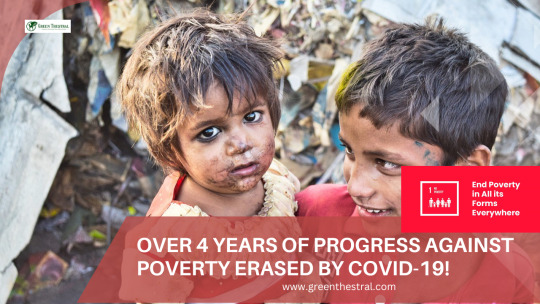
The year 2020 will forever be remembered as a time of unparalleled upheaval, as the COVID-19 pandemic took the world by storm, leaving behind a trail of destruction in its wake. Beyond the tragic loss of lives, the pandemic also unleashed a devastating blow on the global economy and disrupted social systems, derailing the remarkable progress made against poverty over the past four years. The journey towards eradicating poverty that had shown promising strides now stands overshadowed by a daunting reality. This article delves into the impact of COVID-19 on poverty eradication efforts, examining the setbacks, challenges, and potential pathways to recovery.
The Pre-COVID Progress
Before the pandemic struck, significant strides had been made in the battle against poverty. Numerous developing countries had reported declining poverty rates, improvements in education, and better access to healthcare. Global organizations like the World Bank and the United Nations were optimistic that we were moving closer to achieving the Sustainable Development Goal of eradicating extreme poverty by 2030.
Governments, NGOs, and philanthropic organizations were working together, implementing targeted interventions to lift millions out of poverty. Investments were being made in education and vocational training, empowering individuals with skills to secure better-paying jobs. Microfinance initiatives provided small loans to entrepreneurs, fostering local economic growth and self-sustainability. Moreover, access to healthcare has improved through the expansion of health facilities and immunization programs.
The Unforeseen Blow of COVID-19
Enter COVID-19, and the world witnessed an unprecedented human and economic crisis. Lockdowns, travel restrictions, and social distancing measures were put in place to curb the spread of the virus, leading to the shutdown of businesses, the loss of jobs, and disruptions in supply chains. The most vulnerable segments of society were hit hardest, plunging many back into poverty.
Informal workers, day laborers, and those in the gig economy were left without job security or access to social safety nets. Women, who had made significant strides in the workforce, faced a disproportionate burden as they juggled work, childcare, and household responsibilities during the lockdowns.
The Toll on Global Poverty
According to the World Bank, the COVID-19 pandemic pushed an estimated 100 million people into extreme poverty in 2020, erasing more than four years of progress against poverty eradication. The setback was particularly severe in Sub-Saharan Africa and South Asia, where poverty rates surged due to the combined impact of health and economic crises.
School closures further exacerbated the situation, with millions of children unable to access education. This could have far-reaching consequences, as education is a crucial pathway to breaking the cycle of poverty. The disruption in education has the potential to create a lost generation of children who are deprived of the knowledge and skills they need to thrive in the future.
The Hidden Toll on Women
COVID-19 also exposed and amplified existing gender inequalities. Women, who often bear the brunt of poverty, found themselves at the frontline of the pandemic response, comprising the majority of healthcare workers and caregivers. Simultaneously, job losses and economic hardships disproportionately affected women, pushing them deeper into poverty.
Moreover, there was a surge in gender-based violence during lockdowns, as victims were confined with their abusers and faced barriers to seeking help. The pandemic further underscored the urgency of addressing gender disparities and promoting women's empowerment as critical components of poverty eradication efforts.
The Struggle for Access to Healthcare
The pandemic highlighted the glaring gaps in healthcare access and infrastructure in many developing countries. Overwhelmed healthcare systems struggled to provide adequate care to COVID-19 patients while maintaining essential health services for other diseases. This left millions without access to basic healthcare and life-saving treatments.
The economic fallout from the pandemic also affected funding for healthcare, diverting resources away from vital health initiatives. Immunization programs suffered, leading to potential outbreaks of preventable diseases that could disproportionately impact vulnerable communities already reeling from the pandemic's effects.
Climate Change and Poverty: A Two-Front Battle
As if battling a global pandemic was not challenging enough, countries also faced the looming threat of climate change. Climate-related disasters such as hurricanes, floods, and wildfires increased in frequency and intensity, exacerbating poverty and displacing communities.
Vulnerable populations living in low-lying coastal regions or arid areas faced the brunt of climate change impacts, losing their homes and livelihoods. The dual challenges of climate change and poverty necessitate urgent and integrated efforts to build resilience and reduce vulnerability.
A Call for a Resilient Recovery
While the road to recovery may seem daunting, there are glimmers of hope on the horizon. Governments, international organizations, and civil society have an opportunity to build back better, ensuring that the recovery from the pandemic is sustainable, inclusive, and resilient.
Investments in healthcare and social safety nets are crucial to ensure that vulnerable communities are better prepared to weather future crises. Rebuilding livelihoods through job creation, vocational training, and microfinance initiatives can empower individuals to lift themselves out of poverty.
Harnessing Technology and Innovation
The pandemic accelerated the adoption of digital technologies, showcasing their potential to bridge gaps in education, healthcare, and financial services. Leveraging technology and innovation can play a pivotal role in reaching marginalized populations and addressing systemic inequalities.
Mobile banking, telemedicine, and e-learning platforms can enhance access to essential services, particularly in remote areas. Moreover, investments in renewable energy and sustainable infrastructure can create jobs while combating climate change, fostering a greener and more inclusive economy.
Global Solidarity for Lasting Change
COVID-19 has underscored the interdependence of nations and the need for global solidarity in addressing poverty and other global challenges. It is essential for developed nations to support developing countries through financial aid, debt relief, and technology transfer to ensure an equitable recovery.
By collaborating on research, sharing best practices, and working towards common goals, the world can emerge from this crisis stronger and more prepared to confront future challenges. International cooperation is key to ensuring that the progress against poverty does not suffer further setbacks in the face of unforeseen adversities.
Conclusion
The impact of COVID-19 on poverty eradication has been nothing short of devastating. More than four years of hard-won progress has been erased, leaving millions trapped in the cycle of poverty once again. However, the pandemic has also shown the resilience of individuals, communities, and nations in the face of adversity.
As we navigate the uncertain terrain ahead, it is crucial for us to learn from the lessons of the pandemic and forge a path towards a more inclusive and sustainable future. By addressing the underlying issues of poverty, inequality, and climate change, we can build a world that is better equipped to withstand and overcome future challenges, ensuring that the progress against poverty is not only restored but accelerated. Together, we can rise from the ashes of this crisis and create a world where no one is left behind.
What's In It For Me? (WIIFM)
In this eye-opening blog article, you'll discover the harsh reality of the COVID-19 pandemic's impact on poverty eradication efforts. Learn about the setbacks, challenges, and potential pathways to recovery, while gaining insights into the global response and initiatives being taken to build a resilient future. Understand how this crisis affects you, your community, and the world at large, and find inspiration in the call for solidarity and global cooperation. Join us on this journey as we delve into the importance of collective action in ensuring progress against poverty is not only restored but accelerated, creating a world where no one is left behind.
Call to Action (CTA)
Let's stand together and take action against the devastating impact of COVID-19 on poverty eradication. Share this article with your friends, family, and social networks to spread awareness about the challenges faced by vulnerable communities. Engage in discussions, explore ways to support local and global initiatives, and volunteer your time or resources to help those in need. Together, we can make a difference and work towards creating a more equitable and sustainable world for everyone.
Blog Excerpt
The COVID-19 pandemic has dealt a severe blow to the progress made against poverty in recent years. The article sheds light on the unprecedented challenges faced by marginalized communities, the toll on global economies, and the alarming rise in extreme poverty. However, amidst the grim reality, glimmers of hope emerge as we explore potential pathways to recovery. From harnessing technology and innovation to fostering global solidarity, there are ways we can build back better and ensure a more inclusive and resilient future for all.
Meta description in 320 characters to appear in the Google Search Engine
Discover the devastating impact of COVID-19 on poverty eradication efforts. Uncover challenges, pathways to recovery, and calls for global solidarity in this enlightening blog article.
#COVID-19's impact on poverty eradication#Progress against poverty during COVID-19#Global poverty setbacks due to pandemic#Resilience in the face of poverty challenges#Building back better after COVID-19#Poverty eradication and the pandemic#COVID-19's toll on vulnerable communities#Challenges in poverty eradication post-COVID#Pathways to recover from COVID-19's impact#Addressing poverty in a pandemic-hit world#Rebuilding livelihoods after COVID-19#Role of technology in poverty eradication#COVID-19's lasting impact on the poor#Global cooperation for poverty alleviation#Women and poverty during the pandemic#Education setbacks amidst COVID-19#Climate change and poverty during COVID-19#Inequality and COVID-19's toll on poverty#Health crisis worsens poverty#Support for developing nations post-COVID#Opportunities for poverty eradication post-pandemic#Lessons from COVID-19 for poverty efforts#Social safety nets and poverty recovery#Microfinance impact during the pandemic#Sustainable development goals post-COVID#COVID-19's impact on vulnerable children#Gender disparities in pandemic poverty#Addressing the poverty pandemic nexus#A resilient future against poverty and COVID-19#Taking action against poverty post-COVID
0 notes
Text
The WAVES of Change: Women's Valiant Service in World War II 🌊

When the tides of World War II swelled, an unprecedented wave of women stepped forward to serve their country, becoming an integral part of the U.S. Navy through the Women Accepted for Volunteer Emergency Service (WAVES) program. This initiative not only marked a pivotal moment in military history but also set the stage for the transformation of women's roles in the armed forces and society at large. The WAVES program, initiated in 1942, was a beacon of change, showcasing the strength, skill, and patriotism of American women during a time of global turmoil.

The inception of WAVES was a response to the urgent need for additional military personnel during World War II. With many American men deployed overseas, the United States faced a shortage of skilled workers to support naval operations on the home front. The WAVES program was spearheaded by figures such as Lieutenant Commander Mildred H. McAfee, the first woman commissioned as an officer in the U.S. Navy. Under her leadership, WAVES members were trained in various specialties, including communications, intelligence, supply, medicine, and logistics, proving that women could perform with as much competence and dedication as their male counterparts.

The impact of the WAVES program extended far beyond the war effort. Throughout their service, WAVES members faced and overcame significant societal and institutional challenges. At the time, the idea of women serving in the military was met with skepticism and resistance; however, the exemplary service of the WAVES shattered stereotypes and demonstrated the invaluable contributions women could make in traditionally male-dominated fields. Their work during the war not only contributed significantly to the Allies' victory but also laid the groundwork for the integration of women into the regular armed forces.

The legacy of the WAVES program is a testament to the courage and determination of the women who served. Their contributions went largely unrecognized for many years, but the program's impact on military and gender norms has been profound. The WAVES paved the way for future generations of women in the military, demonstrating that service and sacrifice know no gender. Today, women serve in all branches of the U.S. military, in roles ranging from combat positions to high-ranking officers, thanks in no small part to the trail blazed by the WAVES.


The WAVES program was more than just a wartime necessity; it was a watershed moment in the history of women's rights and military service. The women of WAVES not only supported the United States during a critical period but also propelled forward the conversation about gender equality in the armed forces and beyond. Their legacy is a reminder of the strength and resilience of women who rise to the challenge, breaking barriers and making waves in pursuit of a better world.
Read more: https://prologue.blogs.archives.gov/2023/11/06/historic-staff-spotlight-eunice-whyte-navy-veteran-of-both-world-wars/
205 notes
·
View notes
Text
Dear compassionate souls,
I am Raghad, reaching out to you from the heart of Gaza, a place that has become synonymous with resilience and strength in the face of unimaginable challenges. Our story is one of survival, loss, and an urgent plea for help.
For the past weeks, my family of 14 and I have been living in the shadows of fear and uncertainty as Gaza endures relentless and devastating bombardment. The once vibrant streets are now filled with echoes of pain, and our homes have become the frontline of a conflict that claims the lives of our family members, friends, and colleagues daily.
On October 7, our lives were shattered. The IDF called us to evacuate our homes in the Gaza Strip. In a desperate bid for survival, we packed what little belongings we had left and evacuated to another place, hoping against hope that the worst was over. Little did we know that this was only the beginning.
At the moment of the evacuation, our tears were running down, we said goodbye to the rooms of the house and every corner of it, crying looking at the house where I spent 22 years of my life, my father asked us to take pictures of the memory of our house from inside and outside because it may be our last time. We left and there's no news about our house yet. Was it completely destroyed? Is it still there? Nobody knows.
Now, as the situation escalates, we find ourselves facing an unthinkable choice: evacuate for the second time or risk becoming casualties of aggression. Each evacuation brings us face to face with the harsh reality that we might not survive the next bombing.
We suffer from hunger, fear and lack of medical and health capabilities. We have no access to electricity and the internet since the beginning of the Israeli aggression, not to mention the challenges we face as women in these circumstances.
We haven't drank in more than 60 days a clean drop of water and it gets worse with winter coming.
This is where we turn to you, our global community, with a plea for help and a glimmer of hope. We are initiating a GoFundMe campaign to raise funds that will allow us to leave the heart-wrenching aggression that has destroyed Gaza. Our goal is to secure the means to relocate to a safer place, far from the immediate dangers that surround us.
Your support means more than just financial assistance; it signifies solidarity, compassion, and a shared commitment to preserving human lives. Together, we can make a difference and offer my family a chance to rebuild our lives and our dreams
Every donation, no matter the size, will contribute to our journey to safety. Share our story, amplify our plea, and stand with us as we navigate through the darkest days of our lives.
Thank you for being a beacon of hope in our darkest hour.
With gratitude,
Raghad and the entire family from Gaza
*This gofundme is run by the Zanaid family, Raghad's cousins and aunt based in the United States. Your help means everything to us, this is our family, and any donations contribute towards this immense cost (keep in mind they are asking 5-7k per person to leave Gaza as of right now). This is our family, this is our world.
303 notes
·
View notes
Text
I have thoughts about the Tiktok JK deleted

<<I realise its a few days ago now and you might be wondering 'what tiktok?' but I've been writing in snatches when I have a few minutes so it took a while. Anyway, here it is...>>
A few posts I've read have suggested JK did the silly>sexy Tiktok challenge backwards. That he did sexy>silly instead. That he was being random and funny.
I disagree.
What he did was unexpected, a little left of centre, and for the people who can read subtext, not random at all but very very clever.
I'll tell you why, (It may not be what you think) but first I need to vent about two things:
1. Give the man some credit. He knows what he's doing.
There are some who love JK but who see him as a naive innocent. He is not. He isn't a child or a himbo.
Saying he did the challenge just because it's trending, and he reversed the order of the content for a bit of a joke, is insulting to him as an artist. It would suggest he has no forethought or understanding of himself or his (global) audience, and his decisions are made on impulse with no idea of the consequences.
He's very intelligent and has plenty of experience with digital media and creating content. Besides being involved in producing complex visual narratives as part of BTS for the last ten years, he has directed and produced seven highly polished and professional GFC videos. And don't forget the MVs for Life Goes On. For the October issue of Vogue Korea he took on the role of Creative Director. That's a pretty big deal. So we can assume he knows what he's doing.
If he produces content in a particular way, it's because it enables him to communicate what he wants to communicate.
2. You may not understand the message. That doesn't mean there's nothing to understand.
A heads up to people who can't work it out... your inability to grasp meaning doesn't equate to 'no meaning exists'. Suggesting that people who recognise what he's doing are reaching or delusional is an insult to both the audience who can read this situation, and to Jungkook, who is sharing his message.
Consider a system of writing you can't decode. Lack of comprehension doesnt mean the writing is meaningless, it means you don't understand the language.
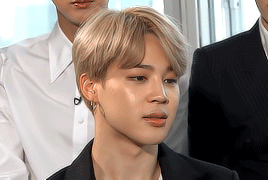
Even if you believe you understand what's being said, please recognise that context may play a role too, that it could reveal a richer and deeper message. Don't just assume the easiest (laziest) interpretation is correct.
(You may have guessed, someone suggested I was 'behaving like the cult' when I pointed out that JK's tiktok was more than being funny ... and now I'm mad 🤣)
Vent over. Now back to he topic at hand...
💜💛
What was he was really doing? And why is it not at all random?
Let's take a step back to recall what army has been saying about this...
Almost every interpretation i read suggests he reversed the order (silly>sexy becomes sexy>silly). The reason given is that his tiktok only makes sense if the order is reversed, and this idea is backed up by the caption saying "I go the other way".
But the 'reversed order' theory is based on a hereronormative perspective of what's sexy (and a stereotypical perspective of silly.)
So consider the content of his tiktok from a queer point of view...
For a man in a relationship with another man, the idea that he's with all those women is silly.
It's silly to believe he's got a girlfriend - or several. It's silly to think the womens' names in the song are relevant to him.
He posted this tiktok at a time when he's releasing music that fits the western pop norm of boy + girl, and when rumours of him dating several women at once are rife. The timing is not a coincidence and nor is the choice of background song for this.
All these assumptions and rumours are pretty silly, JK is telling us.
Now let's talk about the second part, the sexy part. Yes it may look silly on the surface, but we have seen him and Jimin make dorky faces at one another when they're flirting. It seems to be the visual equivalent of calling Jimin 'Jiminssssi'.
It's just another way they create distance and avoid 'getting caught'.

Maybe sexy for Jungkook actually is lying on the couch in your sweatpants making corny faces at your boyfriend.
Remember that he puts out 'stereotypical sexy' on command as part of his job so maybe that doesn't feel very sexy to him. Maybe that's work.
In my view (I know this is subject to interpretation) they've been together for years now. This is not the first flush of love. When you've been with a partner for a while, sex is (hopefully) more fun and less serious. Maybe it's about having the confidence to be wholly unselfconscious.
(My partner makes a Pepé Le Pew face at me when he's goofing. No, i don't know why either... 🤣🤷)

But wait, what about that caption?
What about 난반대로 간다?
My beautiful Korean friend (who sadly has zero interest or care about jikook) confirmed the literal translation:
"I go the other way"
"I take the opposite direction".
It's not "it goes the other way" or "this goes the opposite direction". He's referring specifically to HIMSELF.
Jungkook goes the other way.
But it's more than that according to my friend.
It's a bold statement:
"I don't follow the mainstream."
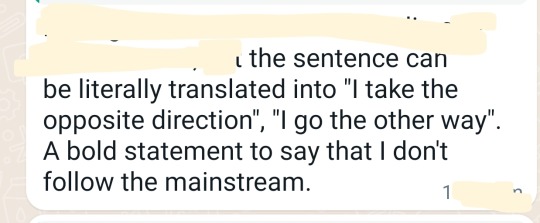
It reminds me of his tattoo ...
RATHER BE DEAD THAN COOL
He doesn't do things just because everyone else is doing them.
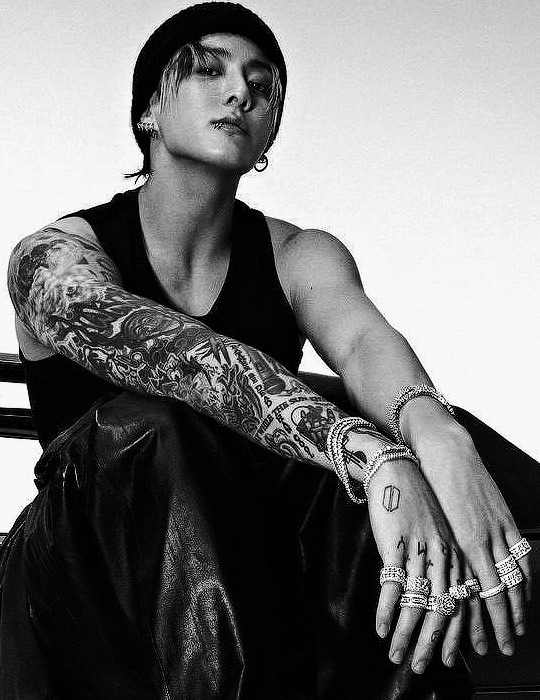
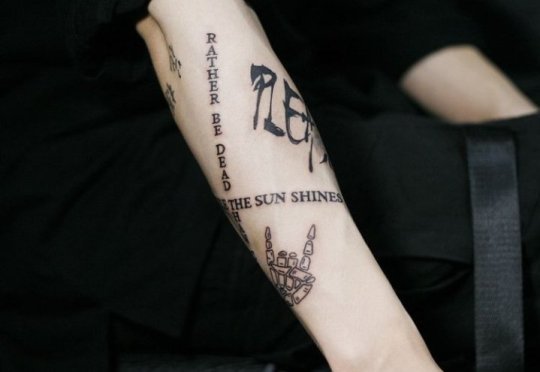
"I don't follow the mainstream."
OK. HOLD UP.
This is where it gets interesting.
Then why would he do something as mainstream as a trending tiktok challenge? Especially something as vapid as this challenge?
And why would he tell us DURING that Tiktok challenge that he DOESN'T follow the mainstream?
And then delete it.
Creating content takes time.
And we know he's a busy man.
He's about to release an album. He's doing live performances. He's prerecording for music shows. He's overseas right now... for the fourth time in a month! Does he have time for this??
And he DELETED it...
Did he just WASTE all that time?
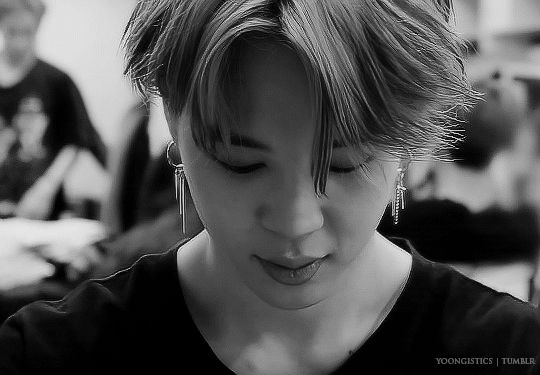
No, he did not.
He deliberately chose to do this.
He did it knowing ARMY studies every action, every video, and every media release.
He did it knowing ARMY would already have copied the video before he took it off his profile.
He said on Stationhead that he knows ARMY has it, and is sharing and posting it. He's FINE with that.
So he took the time to create and upload that video. He wants it out there.
He just doesn't want it on HIS page. That's an important part of the story.
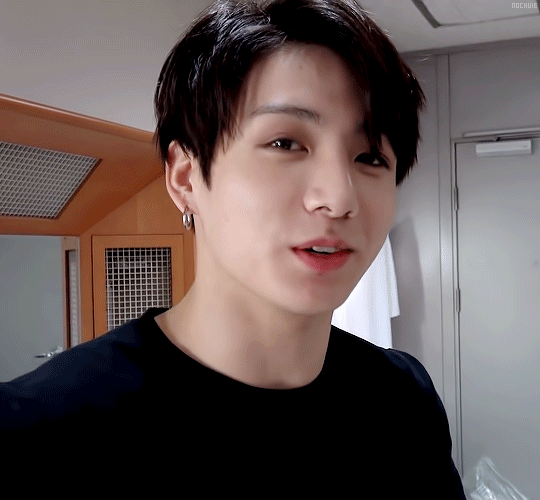
So lets go back to the caption.
"I take the opposite direction"
"I go the other way"
"I don't follow the mainstream."
*Said boldly* remember. It's a loud statement, captioning an otherwise pointless very mainstream trending challenge.
So if he's not referring to tiktok itself, or to uploading challenges, what could he be referring to?
...
...
There's only one thing left: Himself.
I take the opposite direction
I go the other way
I don't follow the mainstream
Essentially... I swing the other way.
There's no way a queer man would make that statement and not fully recognise the message he's sending.
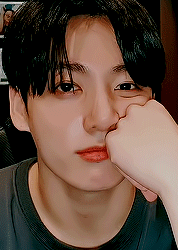
As for deleting the video, I'd say he knew it was too risky to leave on his profile, being a celebrity in Korea. He's managing his brand. Deleting it also gives him plausible deniability. He can say he made an error. As I said, he's very intelligent. He knows ARMY will see it and share it. He knows that those of us with a queer eye will hear the message loud and clear.
🏳️🌈🏳️🌈🏳️🌈 And we do hear it. 🏳️🌈🏳️🌈🏳️🌈
239 notes
·
View notes
Text
Abolition For Beginners (2023 Edition)
In honor of Tyre Nichols and all others we have lost to policing and imprisonment. In honor of Black History Month. In honor of Better Future Program's mission to educate and serve marginalized youth globally... Let's break down abolition, again. (As usual on Tumblr, tap for better quality.)
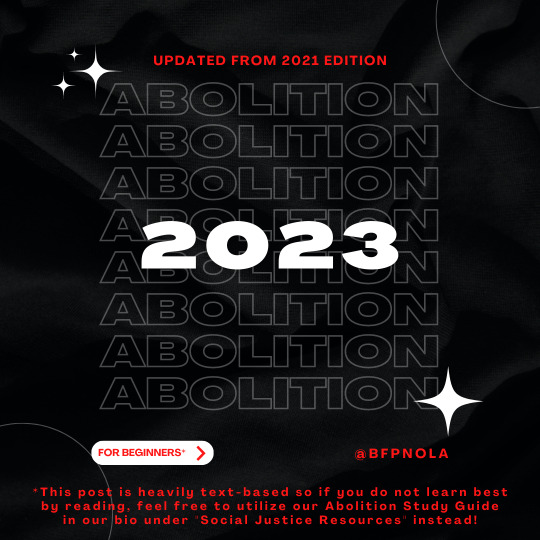
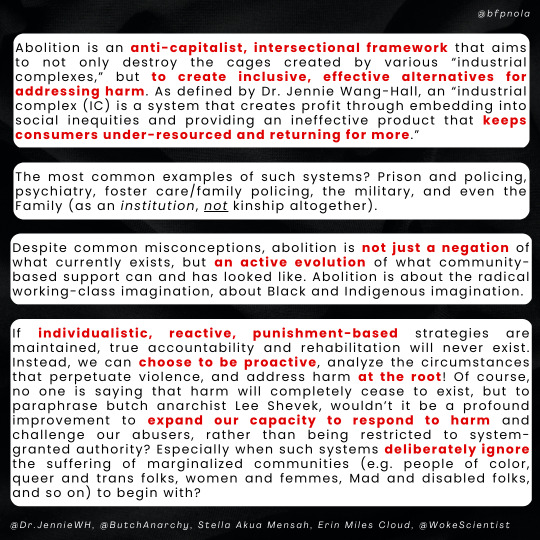

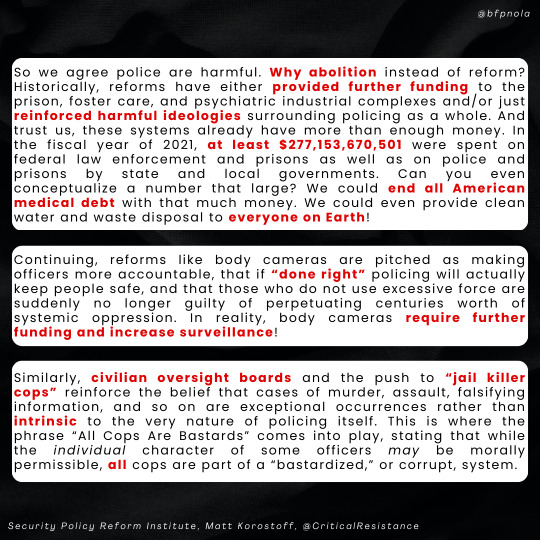
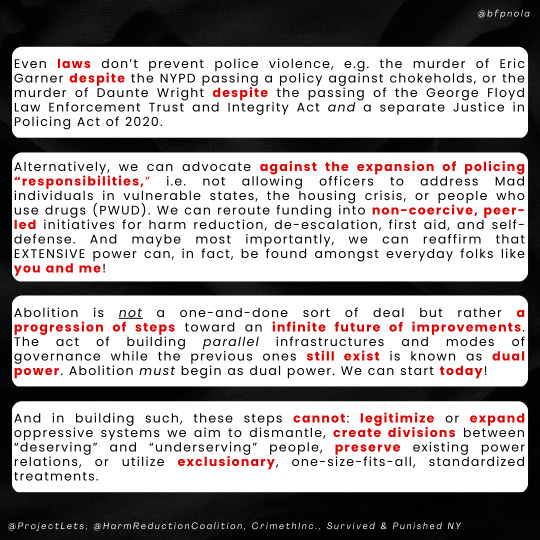


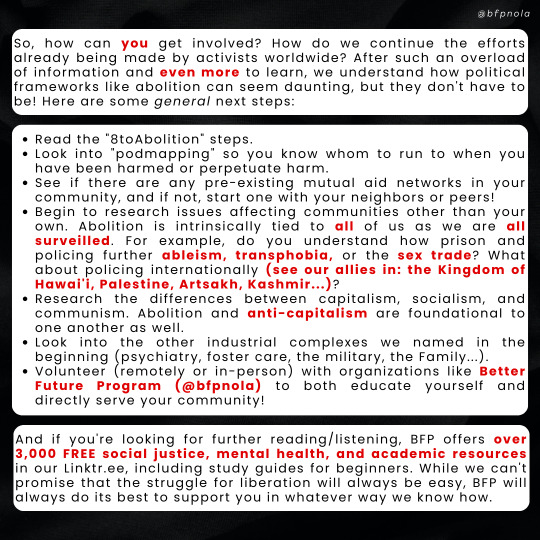
Better Future Program's Linktr.ee | Donate | Liberation Library | Open Leadership Positions | Staff Application | Discord Server
Image description below. Written by @reaux07. Proofread by the volunteers and supporters of @bfpnola.
Image Description:
[ID: All of the following slides use a wrinkled, black fabric as their background with black text (bolded red added for emphasis) on top of white boxes with rounded corners. “@bfpnola” is written in the top right corner and the sources for the slide are in the bottom left corner.
Title Slide (No. 1):
Written in red text, “UPDATED FROM 2021 EDITION.” The outlines of the word “ABOLITION” is written line by line 8 times in light grey with the year “2023” written on top in bold, white lettering. Below, written in red within a white bubble and red arrow, it reads “FOR BEGINNERS*.” Across from the bubble, “@BFPNOLA” is in red. Below, in red again, the asterisk mentioned before leads to the following note: “This post is heavily text-based so if you do not learn best by reading, feel free to utilize our Abolition Study Guide in our bio under "Social Justice Resources" instead!” Lastly, white stars and outlines of grey circles can be seen in each corner of the slide.
Slide No. 2 reads:
Abolition is an anti-capitalist, intersectional framework that aims to not only destroy the cages created by various “industrial complexes,” but to create inclusive, effective alternatives for addressing harm. As defined by Dr. Jennie Wang-Hall, an “industrial complex (IC) is a system that creates profit through embedding into social inequities and providing an ineffective product that keeps consumers under-resourced and returning for more.”
The most common examples of such systems? Prison and policing, psychiatry, foster care/family policing, the military, and even the Family (as an institution, not kinship altogether).
Despite common misconceptions, abolition is not just a negation of what currently exists, but an active evolution of what community-based support can and has looked like. Abolition is about the radical working-class imagination, about Black and Indigenous imagination.
If individualistic, reactive, punishment-based strategies are maintained, true accountability and rehabilitation will never exist. Instead, we can choose to be proactive, analyze the circumstances that perpetuate violence, and address harm at the root! Of course, no one is saying that harm will completely cease to exist, but to paraphrase butch anarchist Lee Shevek, wouldn’t it be a profound improvement to expand our capacity to respond to harm and challenge our abusers, rather than being restricted to system-granted authority? Especially when such systems deliberately ignore the suffering of marginalized communities (e.g. people of color, queer and trans folks, women and femmes, Mad and disabled folks, and so on) to begin with?
Sources: @Dr.JennieWH, @ButchAnarchy, Stella Akua Mensah, Erin Miles Cloud, @WokeScientist
Slide No. 3 reads:
Before we continue any further, let’s destroy the myth that cops actually stop violence. First off, we can’t depend on crime stats at face value because this begs the question of who exactly gets to define what counts as a “crime” and why (e.g. drug possession and sleeping in public vs. tax evasion of the wealthy and wage theft). Continuing, crime rates often only reflect violations that have actually been reported, chosen to be shown, and deemed out of line. By this logic, crime rates are simply reflections of cops’ perceptions, not of the material and emotional realities of the proletariat (i.e. the working-class).
As for perpetuating violence, “US law enforcement killed at least 1,183 people in 2022, making it the deadliest year on record for police violence.” (And those are just the deaths that were reported. In our home state of Louisiana, turns out the Jefferson Parish Sheriff’s Office, as of January 12, 2023, has been unlawfully destroying records of officer misconduct for at least 10 years.) Many (69%) of these murders were cases in which no offense was alleged, were mental health or welfare checks, or involved traffic violations and other nonviolent offenses.
This is, of course, without even touching on the involuntary servitude (i.e. enslavement) and maltreatment ongoing in American prisons. How many more deaths must occur before the general public says enough is enough? Or is this acceptable since these are working-class, disabled, Mad, non-white, queer, and trans lives being lost?
Sources: @InterruptCrim, The Guardian, Mapping Police Violence, @VeriteNewsNola
Slide No. 4 reads:
So we agree police are harmful. Why abolition instead of reform? Historically, reforms have either provided further funding to the prison, foster care, and psychiatric industrial complexes and/or just reinforced harmful ideologies surrounding policing as a whole. And trust us, these systems already have more than enough money. In the fiscal year of 2021, at least $277,153,670,501 were spent on federal law enforcement and prisons as well as on police and prisons by state and local governments. Can you even conceptualize a number that large? We could end all American medical debt with that much money. We could even provide clean water and waste disposal to everyone on Earth!
Continuing, reforms like body cameras are pitched as making officers more accountable, that if “done right” policing will actually keep people safe, and that those who do not use excessive force are suddenly no longer guilty of perpetuating centuries worth of systemic oppression. In reality, body cameras require further funding and increase surveillance!
Similarly, civilian oversight boards and the push to “jail killer cops” reinforce the belief that cases of murder, assault, falsifying information, and so on are exceptional occurrences rather than intrinsic to the very nature of policing itself. This is where the phrase “All Cops Are Bastards” comes into play, stating that while the individual character of some officers may be morally permissible, all cops are part of a “bastardized,” or corrupt, system.
Sources: Security Policy Reform Institute, Matt Korostoff, @CriticalResistance
Slide No. 5 reads:
Even laws don’t prevent police violence, e.g. the murder of Eric Garner despite the NYPD passing a policy against chokeholds, or the murder of Daunte Wright despite the passing of the George Floyd Law Enforcement Trust and Integrity Act and a separate Justice in Policing Act of 2020.
Alternatively, we can advocate against the expansion of policing “responsibilities,” i.e. not allowing officers to address Mad individuals in vulnerable states, the housing crisis, or people who use drugs (PWUD). We can reroute funding into non-coercive, peer-led initiatives for harm reduction, de-escalation, first aid, and self-defense. And maybe most importantly, we can reaffirm that EXTENSIVE power can, in fact, be found amongst everyday folks like you and me!
Abolition is not a one-and-done sort of deal but rather a progression of steps toward an infinite future of improvements. The act of building parallel infrastructures and modes of governance while the previous ones still exist is known as dual power. Abolition must begin as dual power. We can start today!
And in building such, these steps cannot: legitimize or expand oppressive systems we aim to dismantle, create divisions between “deserving” and “underserving” people, preserve existing power relations, or utilize exclusionary, one-size-fits-all, standardized treatments.
Sources: @ProjectLets, @HarmReductionCoalition, CrimethInc., Survived & Punished NY
Slide No. 6 reads:
One of the main questions brought up, though, is what abolitionists plan to do in the case of homicide, rape, domestic violence, and other harms. While this is entirely valid, this question seems to imply that 1) police are already effectively responding to such harms rather than perpetuating and/or ignoring them and 2) that there is one collective abolitionist response.
For one, the majority of sexual assault, for example, goes unreported and less than 0.5% of perpetrators are incarcerated. (And this assumes that through the reporting process and incarceration, survivors will somehow find healing, perpetrators will find understanding, and that sexual assault does not continue within prisons.) Meanwhile, let’s use our hometown as one example of many, a complaint of sexual violence is filed against a New Orleans Police Department officer every 10 days and nearly 1 in 5 NOPD officers have been reported for sexual and/or intimate partner violence.
And secondly, we have a plethora of organizations like Critical Resistance and cultures like that of the Diné (Navajo) to learn from and build upon. We don’t have to be stuck within this false dilemma fallacy, that there is only policing or total chaos. Don’t you see that that is the state’s way of constricting communal power?
Sources: @RAINN, @CopWatchNola, @WokeScientist
Slide No. 7 reads:
To expand this conversation, abolition heavily aligns with the political ideal of “anarchism.” Anarchism supports the absence of government and absolute freedom of the individual. And despite its negative connotations, anarchy also reflects an evolution of community-based care rather than just a deconstruction of what currently exists.
A simplified version of its 6 agreed-upon principles are:
Autonomy and Horizontality: define yourself on your own terms, we stand on an equal footing
Mutual Aid: bonds of solidarity form a stronger social glue than fear, support your community
Voluntary Association: associate or don't associate with whomever you wish
Direct Action: accomplish goals directly rather than depending on representatives or authorities
Revolution: overthrow those in power who enforce coercive hierarchies (ex. white supremacy)
Self-Liberation: you must be at the forefront of your own liberation, freedom must be taken
While being an abolitionist does not require alignment with anarchism, it is worth considering how the state plays such an enduring role in various social harms. Concurrently, whenever you treat other living beings with consideration and respect, come to reasonable compromise rather than coercion, and decide to share or delegate tasks, you are already living by anarchist principles.
Sources: Peter Gelderloos, David Graeber
Slide No. 8 reads:
So, how can you get involved? How do we continue the efforts already being made by activists worldwide? After such an overload of information and even more to learn, we understand how political frameworks like abolition can seem daunting, but they don't have to be! Here are some general next steps:
Read the "8toAbolition" steps.
Look into "podmapping" so you know whom to run to when you have been harmed or perpetuate harm.
See if there are any pre-existing mutual aid networks in your community, and if not, start one with your neighbors or peers!
Begin to research issues affecting communities other than your own. Abolition is intrinsically tied to all of us as we are all surveilled. For example, do you understand how prison and policing further ableism, transphobia, or the sex trade? What about policing internationally (see our allies in: the Kingdom of Hawai'i, Palestine, Artsakh, Kashmir...)?
Research the differences between capitalism, socialism, and communism. Abolition and anti-capitalism are foundational to one another as well.
Look into the other industrial complexes we named in the beginning (psychiatry, foster care, the military, the Family...).
Volunteer (remotely or in-person) with organizations like Better Future Program (@bfpnola) to both educate yourself and directly serve your community!
And if you're looking for further reading/listening, BFP offers over 3,000 FREE social justice, mental health, and academic resources in our Linktr.ee, including study guides for beginners. While we can't promise that the struggle for liberation will always be easy, BFP will always do its best to support you in whatever way we know how.
End ID.]
#reaux speaks#signal boost#tyre nichols#keenan anderson#cop city#abolition#abolish the police#defund the police#anti capitalism#intersectional feminism#palestine#black lives matter#blm#bipoc#disability justice#queer#trans#mass incarceration#study guide#mad liberation#psychiatry#family#military industrial complex#foster care#ACAB#tw rape mention#indigenous#anarchism#pinned post#BLACK HISTORY MONTH
731 notes
·
View notes
Text
Gladys West

Overcoming racial and gender barriers, she charted a course that led her to become a “hidden figure” behind the ubiquitous Global Positioning System (GPS). West’s work has had a profound impact on how we navigate the world today. Her story illuminates often-overlooked contributions of diverse voices in scientific progress. So, how's her work connected to the present?
Gladys West was born in 1930 in rural Sutherland, Virginia. Her family was an Black farming family and she spent much of her childhood working on the farm, surrounded by sharecroppers. Despite the challenges, she excelled in school and was determined to get an education. West's childhood on a farm instilled in her a deep understanding of precision and calculation. Despite limited resources and societal constraints, she excelled in academics, graduating with a mathematics degree from Virginia State University and went on to earn two master's degrees and a PhD. Her talent propelled her to the Naval Surface Warfare Center, where she embarked on a remarkable 42-year career. It was also there she met her husband, Ira, married in 1957, and had 3 children. She was the 2nd Black woman ever hired, and 1 of 4 Black employees, her husband included.
There, with the backdrop of Cold War tensions and burgeoning space exploration, West tackled complex mathematical problems related to satellite geodesy. This specialized field, equivalent to deciphering Earth's celestial fingerprint, held the key to precisely pinpointing locations in space. West's meticulous calculations, particularly for the groundbreaking Seasat and GEOSAT satellites, became the invisible scaffolding upon which the modern GPS system was built.
For decades, her contributions remained largely unacknowledged due to her race and gender. Yet, the accuracy and efficiency of her work spoke volumes. The precise models she developed for Earth's gravitational field and its subtle variations due to tides and other forces became the bedrock of GPS calculations. Today, whether navigating city streets or pinpointing remote wilderness locations, we unknowingly benefit from West's invisible hand.
Recognition finally arrived later in life. In 2018, the Air Force Space and Missile Pioneers Hall of Fame inducted West, acknowledging her transformative impact. That same year, the BBC included West among its "100 Women," recognizing her groundbreaking contributions. Just three years later, the Royal Academy of Engineering in the UK bestowed upon her their highest individual honor, the Prince Philip Medal, cementing her place as a pioneer in her field. But her legacy extends far beyond accolades. Gladys West stands as a beacon of inspiration, not just for aspiring mathematicians, but for anyone facing systemic barriers. Her story reminds us that the path to groundbreaking discoveries is often paved by those who defy expectations and chart their own unique course.
youtube
Photo Source: Wikimedia
Source: Wikipedia
Source: BBC
Source: Britannica
Source: Atlanta Black Star
111 notes
·
View notes
Text
In the dynamic tapestry of influential women, Malala Yousafzai and Taylor Swift emerge as beacons of inspiration, each weaving a unique narrative of triumph over challenges. Malala's unwavering commitment to education rights, forged through a harrowing encounter with the Taliban, contrasts with Taylor Swift's musical prowess and resilience against the scrutinizing lens of fame. As we delve into their achievements, struggles, and the echoes of their empowering quotes, the question arises: Who stands as the superior role model in this diverse spectrum of impactful women? Join us in unraveling the intricate threads of their journeys and discover the powerful lessons embedded in the narratives of Malala Yousafzai and Taylor Swift.
**Malala Yousafzai:**
1. **Achievements:**
- Malala Yousafzai is a Nobel laureate and education activist who stood up for girls' education rights in Pakistan, especially in the face of the Taliban's oppressive regime.
- Her advocacy work led to the co-founding of the Malala Fund, a non-profit organization focused on promoting education for girls globally.
2. **Struggles:**
- Malala faced severe adversity when she was shot by the Taliban at the age of 15 for advocating girls' education. Her remarkable recovery and continued commitment to her cause exemplify her resilience.
- She endured ongoing threats and challenges but remained steadfast in her dedication to promoting education for girls.
3. **Quotes:**
- "We realize the importance of our voices only when we are silenced."
- "One child, one teacher, one book, one pen can change the world."
**Taylor Swift:**
1. **Achievements:**
- Taylor Swift is a highly successful and influential singer-songwriter with numerous awards, including 11 Grammy Awards and an Emmy.
- Swift has been an advocate for artists' rights, influencing changes in the music industry, such as her role in prompting Apple Music to change its policy on compensating artists during its free trial period.
2. **Struggles:**
- Swift has faced challenges in the public eye, including media scrutiny of her relationships and public disputes with other celebrities. She has transformed these challenges into opportunities for artistic expression.
- Swift has been an advocate against online harassment, revealing struggles she faced with body image and self-esteem, emphasizing the importance of mental health.
3. **Quotes:**
- "I think there is a lesson in knowing that you can live your life in a way that you’re proud of and people are still gonna take shots."
- "You are not the opinion of someone who doesn't know you."
**Comparison:**
1. **Achievements:**
- Malala's achievements are deeply rooted in activism and global advocacy for education rights, impacting the lives of marginalized girls globally.
- Taylor Swift's achievements lie in the realm of entertainment and industry influence, using her platform to address issues such as artists' rights.
2. **Struggles:**
- Malala faced life-threatening adversity for her activism, highlighting the gravity of her mission.
- Taylor Swift's struggles are often in the public eye, with media scrutiny and controversies, which she navigates with resilience.
3. **Role Model:**
- Malala is a powerful role model for her unwavering commitment to education and her courage in the face of adversity.
- Taylor Swift serves as a role model in the entertainment industry, demonstrating resilience and using her platform for positive change.
In conclusion, both Malala Yousafzai and Taylor Swift are influential figures who have overcome challenges in different realms. Malala stands out as a global education activist with unparalleled courage, while Taylor Swift serves as a role model in the entertainment industry, using her platform for positive change. The choice of a "better" role model depends on individual values and the impact one seeks in the realms of education activism or entertainment.
76 notes
·
View notes
Text
The class structure of capitalism encourages men who wield power in the economic and political realm to become routine agents of sexual exploitation. The present rape epidemic occurs at a time when the capitalist class is furiously reasserting its authority in face of global and internal challenges. Both racism and sexism, central to its domestic strategy of increased economic exploitation, are receiving unprecedented encouragement. It is not a mere coincidence that as the incidence of rape has arisen, the position of women workers has visibly worsened. So severe are women's economic losses that their wages in relationship to men are lower than they were a decade ago. The proliferation of sexual violence is the brutal face of a generalized intensification of the sexism which necessarily accompanies this economic assault.
Following a pattern established by racism, the attack on women mirrors the deteriorating situation of workers of color and the rising influence of racism in the judicial system, the educational institutions and in the government's posture of studied neglect toward Black people and other people of color. The most dramatic sign of the dangerous resurgence of racism is the new visibility of the Ku Klux Klan and the related epidemic of violent assaults on Blacks, Chicanos, Puerto Ricans and Native Americans. The present rape epidemic bears an extraordinary likeness to this violence kindled by racism.
Given the complexity of the social context of rape today, any attempt to treat it as an isolated phenomenon is bound to founder. An effective strategy against rape must aim for more than the eradication of rape—or even of sexism—alone. The struggle against racism must be an ongoing theme of the anti-rape movement, which must not only defend women of color, but the many victims of the racist manipulation of the rape charge as well. The crisis dimensions of sexual violence constitute one of the facets of a deep and ongoing crisis of capitalism. As the violent face of sexism, the threat of rape will continue to exist as long as the overall oppression of women remains an essential crutch for for capitalism. The anti-rape movement and its important current activities—ranging from emotional and legal aid to self-defense and educational campaigns—must be situated in a strategic context which envisages the ultimate defeat of monopoly capitalism.
—Angela Davis, Women, Race & Class (1981), p 200-201
#god I wish the feminism that exploded in past decades was based on angela davis she was right about so many things#angela davis#misogyny#racism#antiblackness#misogynoir
67 notes
·
View notes
Text


"As Palestinian women today, we find ourselves in a harrowing struggle, contending not only with an ever-present threat to our safety, but also with insidious patriarchal manipulation aimed at undermining our cause and our resistance. Israel's systematic use of sexual violence against Palestinians has endured since the 1948 Nakba.
This disturbing reality is not confined to Palestinian testimonies, but finds chilling corroboration in the accounts of retired Israeli soldiers implicated in massacres such as the one that unfolded in Tantura.
The same insidious tactic of weaponising patriarchy and exploiting the bodies of Palestinian women continues unabated amid the ongoing genocide in Gaza.
In the face of the ongoing atrocities and sexual violence against Palestinian women, supported by evidence and testimonies, it is imperative for feminists worldwide to rise in solidarity and demand justice.
The weaponisation of patriarchy against our bodies, our cause and our people is a reprehensible tactic that must be exposed and condemned. We must also challenge the complicity of the global media and colonial "feminists" in perpetuating our dehumanisation and silencing our voices.
The time for action is now. We call upon feminist activists, organisations and allies to stand with Palestinian women, amplify our narratives and advocate for accountability and an end to Israel's occupation, siege and genocide. Let us work together to dismantle systems of oppression and build a world where the rights and dignity of all women are upheld and respected.
Our struggle is not ours alone; it is a universal fight for justice, equality and liberation - now more than ever. Join us in solidarity as we continue to resist and persist until every Palestinian is free from the shackles of violence and oppression."
Opinion by Falastine Saleh
#free Palestine#free gaza#I stand with Palestine#Gaza#Palestine#Gazaunderattack#Palestinian Genocide#Gaza Genocide#end the occupation#Israel is an illegal occupier#Israel is committing genocide#Israel is committing war crimes#Israel is a terrorist state#Israel is a war criminal#Israel is an apartheid state#Israel is evil#Israeli war crimes#Israeli terrorism#IOF Terrorism#Israel kills children#Israel kills innocents#Israel is a murder state#Israeli Terrorists#Israeli war criminals#Boycott Israel#end Israeli terror#end Israeli occupation#end Israeli apartheid#Israel is a genocidal state#free Palestine 🇵🇸
41 notes
·
View notes
Text
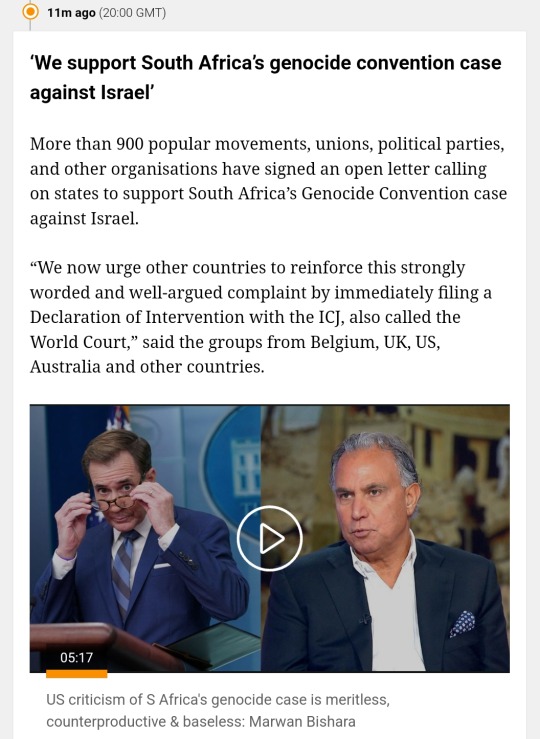

I got distracted with this email set up I found, I'm dropping it here for you all
Take these emails:
[email protected]; [email protected]; [email protected]; [email protected]; [email protected]; [email protected]; [email protected]; [email protected]; [email protected]; [email protected]; [email protected]; [email protected]; [email protected]; [email protected]; [email protected]
Take this subject:
South Africa VS Israel in the ICJ.
Take this letter:
Dear Madam President and esteemed panel of Judges,
I hope this message finds you well and resolute. My name is [your name], I am a concerned citizen of [your country]. I am reaching out to you with a sense of urgency and sincere apprehension which prompts me to break my customary silence.
I have always held the belief that individuals in positions of authority, such as yourself, harbour the best interests of humanity at heart. However, recent developments in the Middle East and the global response to them have stirred doubt in my convictions, compelling me to express my concerns directly to you.
As I explored the International Court of Justice's website, I took solace in the fact that it consists of "independent judges, elected regardless of their nationality from among persons of high moral character." With this understanding, I address you regarding the impending South Africa v. Israel matter, the provisional measures hearing of which is scheduled for Thursday, 11th and Friday, 12th January 2024.
I am sure that you are acutely aware of the gravity of the case before you, and I believe that your ability to discern the truth, resist external pressures, and deliver a just judgment is foremost on your mind. The Genocide Convention, a cornerstone of international law, was established in 1948 as a commitment to 'never again' allow atrocities akin to those committed by the Nazi’s in WW2. 152 states out of 194 nations of the world honourably signed up to the convention. It is a testament to our parents and grandparents that their generations committed to a set of standards that constitute the basic principles of right and wrong, which underpin the fabric of the world we live in and form the basis of the lives most of us are lucky enough to lead.
The very fact that the responsibility of adjudicating on this case has fallen upon your shoulders underscores a disheartening truth – the failure of existing systems of checks and balances within the international community. It is disconcerting that national interests have tainted the operations of our global systems, allowing the mass killing of civilians to persist without intervention. I find this reality appalling, as do countless citizens around the world who have expressed their horror through protests on the streets of cities across the globe.
The upcoming case is a litmus test for humanity's commitment to the solemn pledge of 'Never Again.' Generations have been educated about the horrors of the Holocaust, and this case challenges us to live up to the principles we profess. It is a stark reminder that the values we hold dear are being tested in real-time, with devastating consequences.
In March 2022, the International Court of Justice ordered Russia to immediately suspend military operations in Ukraine and ensure that affiliated units take no further steps in furtherance of the military operations. Despite this intervention, an estimated 10,000 civilians have tragically lost their lives in Ukraine since Russia's military operation in 2022. Moreover, and by comparison, the death toll in Gaza has already surpassed 22,000 since October 2023, with a staggering 70% of the victims being women and children.
In an age where mainstream media faces scepticism due to perceived biases, the global community has been witness to Israel's actions in real-time through various social media platforms such as Twitter, TikTok, and Telegram.
We find ourselves in a world where trust in global institutions is eroding rapidly. The International Court of Justice, in particular, cannot afford to make an erroneous judgment in the South Africa v. Israel genocide case. A misjudgement in this matter would not only underscore the ICJ's ineffectiveness but also prompt scrutiny regarding its autonomy from nation-state political influences, potentially compromising the esteemed moral character of the individuals involved.
In 1945 we celebrated Winston Churchill as the leader that brought the world together in war to put-down the threat of Nazi Germany and the horror it inflicted. That war claimed over 50 million lives. We do not wish to celebrate a wartime hero again; we wish to celebrate new heroes who averted a war by presiding over justice without fear or favour.
I humbly beseech you to approach this case with the utmost diligence, impartiality, and commitment to justice. The eyes of the world are upon you, and the outcome of this particular case will reverberate through history, shaping perceptions of the ICJ's impartiality and moral standing.
Yours sincerely,
[your name]
Email that shit and do your part, we are fucking obligated as living beings on this planet.
#free gaza#free palestine#gaza strip#irish solidarity with palestine#palestine#gaza#news on gaza#al jazeera#boycott israel#israel#ICJ#International Court of Justice#South Africa VS Israel#Genocide Convention#World Health Organisation#Al-Awda Hospital#Jabalia
54 notes
·
View notes
Text
A brief summary of how Education fails Boys
I saw people sincerely questioning and minimizing the current struggles boys face in education.
So, I wanted to collect some relevant information, with sources. All of these are from the past couple of years, from 2021 onward.
Girls have more difficulty accessing education and are more likely than boys to be out of school at primary level. However, boys are at greater risk of repeating grades, failing to progress and complete their education, and not learning while in school. Globally, 128 million boys are out of school. That’s more than half of the global out-of-school youth population and more than the 122 million girls who are also out of school.
The Leave no child behind: Global report on boys’ disengagement from education shows that boys are increasingly left behind in education. They are at greater risk of repeating grades, failing to progress and complete their education, and not learning while in school. While previously boys’ disengagement and dropout were concerns mainly in high-income countries, several low- and middle-income countries have seen a reversal in gender gaps, with boys now lagging behind girls in enrolment, completion and learning outcomes. Boys are more likely than girls to repeat primary grades in 130 countries, and more likely to not have an upper secondary education in 73 countries. At tertiary level, globally only 88 men are enrolled for every 100 women.
In 1970, women only made up 42 percent of the college population. Today, the roles have essentially reversed. The U.S. Department of Education estimates men to make up 43 percent of enrolled individuals in college. And this crisis impacts minority populations even more: only 36 percent of Black and 40 percent of Hispanic bachelor degree recipients are male.
This is not an issue of colleges neglecting to admit men at an equal rate. Rather, colleges are receiving fewer applications from men than women. In 2010, only 44 percent of college applications were from men and that number has been steadily declining since. The decrease in male applicants is a sign that men are discouraged from pursuing higher education at a disproportionately high rate.
These statistics point to a larger, systemic problem. The American education system perpetuates a series of gender norms that cause significant harm to children; boys are impacted by these expectations in a way that tends to be overlooked. The stereotype that boys have a higher propensity to misbehave has led to the over-punishment of boys in the classroom.
Boys are facing key challenges in school. Inside the effort to support their success
An APA task force is spotlighting the specific issues and recommending evidence-based ways to enact swift change
At school, by almost every metric, boys of all ages are doing worse than girls. They are disciplined and diagnosed with learning disabilities at higher rates, their grades and test scores are lower, and they’re less likely to graduate from high school (Owens, J., Sociology of Education, Vol. 89, No. 3, 2016; Voyer, D., & Voyer, S. D., Psychological Bulletin, Vol. 140, No. 4, 2014; “The unreported gender gap in high school graduation rates,” Brookings, 2021). These disparities persist at the university level, where female enrollment now outpaces male enrollment by 16% (Undergraduate Enrollment, National Center for Education Statistics, 2022).
“The gap between boys and girls is apparent from very early on,” said developmental psychologist Ioakim Boutakidis, PhD, a professor of child and adolescent studies at California State University, Fullerton. “The disparities not only exist across the board—from kindergarten all the way to college—but they are growing over time.”
For boys of color, that gap is even larger. They face suspension and expulsion from school at almost five times the rate of their White male classmates and are even less likely to finish high school or college (“Exploring Boys’ (Mis)Behavior,” Society for the Psychological Study of Men and Masculinities, 2022 [PDF, 261KB]).
The implications of these disparities are huge. Doing poorly at school is strongly associated with major challenges later in life, including addiction, mental and physical health problems, and involvement with the criminal justice system—problems that also have ripple effects on society at large. In the United States, getting at least a college degree may be the one remaining, relatively stable ticket to a decent life, Boutakidis said.
In a recent New York Times essay, “It’s Become Increasingly Hard for Them to Feel Good About Themselves,” Thomas Edsall reviews a variety of research studies highlighting the plight of young men in the United States. As a front-line educator who has worked in boys’ schools for 30 years and served as the head of a boys’ school for the past 20 years, I’ve been an unhappy witness to this dilemma.
Data supports the claim that boys are falling behind, and dramatically so. For example, there is a growing gender gap in high school graduation rates. According to the Brooking Institution, in 2018, about 88% of girls graduated on time, compared with 82% of boys.
For college enrollment, the gender gap is even more striking, with men now trailing women in higher education at record levels. Last year, women made up 60% of college students while men accounted for only 40%, according to statistics from the National Student Clearinghouse. College enrollment in the United States has declined by 1.5 million students over the past five years, with men accounting for 71% of that drop.
45 notes
·
View notes
Text
Notes on "Empire of Care : Nursing and Migration in Filipino American History"

Filipino nurse migration to the United States is just one aspect of a larger global flow of predominantly female migrants from the Philippines to over 130 countries.
This migration trend contrasts with early Philippine immigration, which consisted mainly of male labourers to the United States

The migration of highly skilled nurses across borders is both a celebratory sign of their training and expertise but also highlights global power dynamics, where nurses from countries with severe nursing shortages migrate to provide care in highly developed countries like the United States, Canada, and the United Kingdom.
Despite the important role of Filipino nurse migrants, little is known about their development and experiences.
Existing studies often group Filipino nurse migrants with other Asian professional migrants, which masks the unique aspects of their migration.
These studies often explain Filipino nurse migration through U.S. immigration legislation and economic opportunities, such as the 1965 U.S. Immigration Act and nursing shortages after World War II.
The "brain drain" theory is commonly used to explain professional migration from Asian countries, suggesting that professionals leave due to a lack of opportunities and economic incentives in their home countries.
Filipino nurse migrants are sometimes depicted as impersonal objects of study, preventing a comprehensive understanding of their multidimensional roles as historical agents, professionals, women, and immigrants.
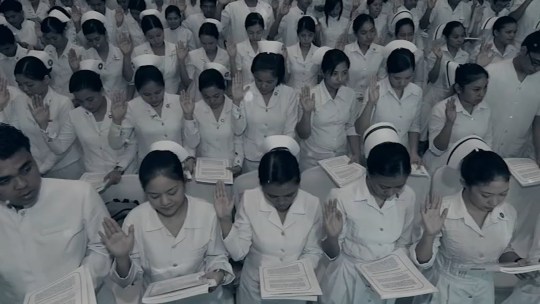
The migration of highly skilled nurses reflects a global power structure where countries with nursing shortages, including the Philippines, send nurses to provide professional nursing care in highly developed countries like the United States, Canada, and the United Kingdom. The World Health Organization (WHO) report highlights the inequitable distribution of nurses worldwide, with developing countries having only 15 percent of the world's nurses despite housing two-thirds of the world's population (Empire of Care).
The culture of migration, shaped by narratives about the promise of immigration to the United States, including media portrayals and experiences shared by Filipino nurse migrants already in the U.S, plays a significant role in motivating Filipino nurses to seek opportunities abroad.
U.S. hospital recruiters actively collaborate with Philippine travel and recruitment agencies to aggressively recruit Filipino nurses, shedding light on what some researchers call the "institutionalisation of migration." However, these aspects are often overlooked in research, leaving a "critical void" in understanding the dynamics of Filipino nurse migration.
The lack of study about the exploitation faced by Filipino nurses from both Philippine and American recruiters and their American hospital employers is concerning. Additionally, the scapegoating of Filipino immigrants during challenging political times and the absence of professional solidarity between Filipino and American nurses remain underexplored issues.
The studies that include Filipino nurse migrants also marginalise and simplify the complex and dynamic history of the colonial relationship between the United States and the Philippines.
Pervasive myths of U.S. exceptionalism and benevolence persist and influence the perception of colonial history, downplaying the violent conquest of the Philippines and the racialized hierarchies it created. These myths are also perpetuated in contemporary times through media narratives about immigration and the incorporation of the "Third World" into the United States.
Despite their highly educated and skilled backgrounds, professional Asian immigrants, including Filipino nurses, still face resentment and hostility, as exemplified by the case of nuclear physicist Wen Ho Lee.

Foreign nurses, especially Filipino nurses, have been criticised for "taking jobs" from American nurses, leading to debates about their immigration and examination requirements. This criticism often overlooks the complex factors involved in Filipino nurse migration and the collaboration between Philippine and U.S. entities in facilitating the process. It also implies that Filipino nurses exploit the United States, rather than the reality of the situation (the United States exploiting Filipino nurses).
The history of U.S. colonialism in the Philippines perpetuated the interrelated myths of "white love" and "little brown brothers." These myths claimed that Americans embraced their colonial subjects with benevolence and enlightened American systems of education, infrastructure, and public health. Not only does this further promote the myths of American benevolence and American exceptionalism , it portrays Americans as superior to their Filipino counterparts in a racialised hierarchy.
American Exceptionalism in this context means Americans juxtaposing themselves against their "Brutal, European counterparts" in order to paint themselves as a benevolent force in the Philippines.
#Empire of care#Philippines#the philippines#Filipino history#filipino american#Pinoy#Filipino#Filipina#us colonialism#us imperialism#US exceptionalism#Colonialism#Colonial history#History#Asian history#American history#Books#My books#Personal#🇵🇭#Swagapino#I shuddered upon typing “little brown brothers” and “white love” LMAOOO#Started this last night and finished it like 10 mins ago#I also laughed upon reading that American nurse complaining about Filipino nurses implying that Filipinas were exploiting the US#The audacity
103 notes
·
View notes
Text
"What does it mean to take a comparative approach? First, we have to move away from the imperialist notion that misogyny only exists elsewhere in countries with “backward” cultures and religions, take a long hard look at the oppression that women face in the heart of empire, and explain how both are tied together.
For example, women in various countries around the world are killed by family members. In Pakistan, this amounts to about a thousand. Pakistan is a country of 140 million people. This is a serious problem, and as feminists, progressives, and leftists, we shouldn’t paper over these realities. However, we should also challenge the ways in which these murders are characterized. To call them “honor killings” as if religion and culture are solely responsible for the murder of women, gives a complete pass to the larger economic, political, and social conditions that produce this violence.
These conditions are important because a similar set of conditions produce horrific levels of violence against women in the United States. Here, 1500 women are killed by their spouses or boyfriends each year in what are called “crimes of passion.” From 2002 to 2012, the number of women killed by intimate partners was 15,462. The US has a population of 300 million, twice the size of Pakistan, but the figures nonetheless are comparable. However, in the mainstream framing of the issue of violence against women, we hear about the murders of women “out there,” but rarely about what happens here. Every day about four women are killed by intimate partners in the United States, but we don’t know their names, we don’t know their stories, and even when we do it is discussed as individual aberrations, crimes driven by passion, rather than by a society that systematically treats women as second class citizens. So rather than resort to this clash of civilizations framing, where “our” misogyny is either papered over or reduced to individual aberrations, while “theirs” is viewed as a product of their backward culture, what we need to do instead is to conduct a concrete analysis of what produces violence against women globally. This necessarily involves looking at structural factors rather than just culture, either “rape culture” or “Islamic culture.”"
182 notes
·
View notes
Text
Teenage girls know a lot more about democracy and what makes it tick than teenage boys, but when it comes to political ambition the boys win hands down.
A global study of 82,000 teenagers from 22 countries showed that almost without exception girls had a greater engagement with and understanding of government, equality, public trust, voting and representation, than their male peers.
But boys were more likely to say they were interested in becoming a politician
“Australian girls are outperforming boys on knowledge, attitudes and values that support a greater competency when it comes to participation in civic life,” said Rachel Parker, from the Australian Council of Educational Research, who worked on the study.
“One of the few areas where boys outperform girls in the study is the intention to be politically active.”
The report, Education for Citizenship in Times of Global Challenge, found that girls were far more knowledgeable about how parliament works, globalisation, independence of statutory authorities and voting and representation.
Girls were also far more likely than boys to support gender equality and equal rights for migrants and cultural groups to access education, employment and political participation.
They were more engaged with big issues such as environmental protection and more likely to participate in civic activities.
However, girls were less likely to report expecting to join a political party or a trade union or stand as a candidate in an election.
The study did not dig into the reasons why, but previous research identified parental influence and societal expectations as feeding gender norms relating to political ambition, as well as widely held perceptions that politics is a man’s world.
Indeed, 40 per cent of boys thought men are better suited to being political leaders than women, while 25 per cent agreed with the statement that women should stay out of politics.
Ella Curran, 18, harboured an ambition to become a politician when she was in Year 9, but a school excursion to Canberra cured her of that notion.
“I started to think more realistically about the sort of lifestyle I wanted for myself. And we did a legal studies excursion to Parliament House and watched question time,” she told AFR Weekend.
“I felt it was so aggressive and personal in the insults that were being thrown about that I just thought it was not the sort of workplace I could feel comfortable in,” said Ms Curran, a first-year arts and philosophy student at the University of Sydney.
“I’m just not prepared to face that kind of abuse or have my appearance or relationship status mocked in public rather than focus on what I am actually doing.”
Ms Curran’s two great passions are climate change and gender equality.
“I’m concerned about climate change, particularly Australia’s response to that because we are one of the worst countries in the world for our emissions,” she said.
Lulu Hamilton, 16, who counts women’s rights and climate change as her two greatest passions, also harboured a fleeting ambition to become a politician when she was younger but abandoned it without any fanfare.
“I thought it was the best platform to make change because if I could have power, I could make my goals become a reality,” Ms Hamilton said.
Having spent the first 12 years of her life in China, seeing democracy in action, including the free exchange of information and ideas, was a head-spinning affair.
“It was such a jarring difference. I never would have spoken to my friends in China about climate change, gender or politics. Even our textbooks had stuff whited out because the Chinese government didn’t want us to read about Tibet and Taiwan. We had very limited access to media.”
As for a future in politics? That’s out of the question.
“I feel the negatives outweigh the positives.”
32 notes
·
View notes
Text
The last week of "calm" in my country has just started. I honestly fear for the worst scenario. Argentina is facing a big dichotomy in which there are more than economic consequences; we vote for president and choosing has never been easier.
One of the candidates, Javier Milei, represents everything I don't want for my country (nor any country). A man (and team) that revendicates the worst time in our country, where genocide and torture occurred. A man who lacks from mental stability, and we are not talking about simple mental health issues, he is unable to guide the destiny of 45M of habitants. A man who despise women, and every minority; A man who has repeatedly promoted the free use of guns and the free market of organs and body parts (yes) as one of his main campaign promises. A man who has repeatedly promoted ideas of paedophilia. A man whose main strategy is to SCREAM, INSULT AND DENIGRATE others (specially women). He plans to eliminate the public health system, destroy the public educational system (we are praised because of those two, worldwide) and allow the rich to contaminate rivers, because he says water should be PRIVATIZED. A man who DOESN'T BELIEVE in GLOBAL WARMING AND CLIMATE CHANGE. A man who revendicates Israel outrageous genocide over Palestine. Let alone the devastating economical consequences over an already destroyed economy (mainly created by the ones who have ultimately allied with him).
The challenge now will not be being able to eat or prosper, it will be to stay ALIVE as a woman or a minority. Most of his followers are VIOLENT people. They HATE, they promote everything I am against to. I want more rights for the people, I don't want hate, nor misogyny. I don't want kids to be abused, nor killed at their schools. This is, unfortunately, a little description of our near future if this man wins the election this sunday. Therefore, I only pray for the people in this country to use their hearts instead of profound hate towards the others.
What am I trying to say with all of this? our world -not only my country- is in severe chaos. Please, don't let people like this have the power over our lives and the next generations.
39 notes
·
View notes